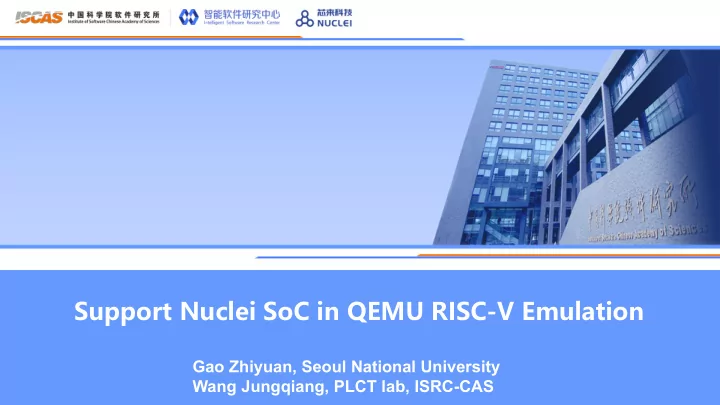

Support Nuclei SoC in QEMU RISC-V Emulation Gao Zhiyuan, Seoul National University Wang Jungqiang, PLCT lab, ISRC-CAS
Nuclei Products and Offerings
We chose Nuclei HummingBird (N307), GPIO, UART0, UART1 QSPI0, QSPI1, QSPI2 PWM0, PWM1, PWM2 I2C, No MMU An alternative for ARM Cortex-M3/M4/M4F/M33.
What are needed to support Nuclei RISC-V CPU implementations: target/riscv/cpu.c overwriting configs for spec Extended customized CSR registers ECLIC: Enhanced Core Local Interrupt Controller Timer UART GPIO NMI: non-maskable interrupt …
Interrupt Controllers CLIC: Core Local Interrupt Controller (SiFive) CLINT: Core Local Interrupter (SiFive) PLIC: Platform Level Interrupt Controller (SiFive) ECLIC: Enhanced Core Local Interrupt Controller (Nuclei)
Cores CLIC only adopted by SiFive E2 series and S2 series Other SiFive cores support CLINT and PLIC interrupt controller ECLIC: only in Nuclei Cores
CLIC vs. CLINT vs. ECLIC CLINT: Fixed priority scheme based on source id Only software and timer interrupts. Other interrupts are wired directly to the CPU. CLIC: Programmable interrupt levels, priorities Support nested interrupts (preemption) ECLIC: 4096 interrupt sources Configurable priority, enable/disable, level-triggered or edge-triggered Nested Interrupts and tail-chaining
ECLIC Implementation ECLIC class init Nuclei device create a ECLIC device register properties (e.g. num_sources, size) connect to sysbus ECLIC device realize Allocate space for registers per input source (e.g. clicintattr, clicintie, clicintip) connect eclic with GPIO/UART/Timer for related interrupts When an interrupt happens, IRQ is added to pending array of irqs Update the array of IRQs, deal with nested or tail chaining cases
Registers in ECLIC Registers per interrupt source clicintip: the interrupt polarity, deciding whether IRQs are triggered together with clicintattr clicintie: enables or disables the interrupt source clicintattr: defines a level-triggered, rising-edge triggered, or falling-edge triggered IRQ clicintctl: contains priority and level values Registers in ECLIC cliccfg: configures effective bits within clicintctl for interrupt priority calculation clicinfo: read-only register defining hardware version, # of sources, effective bits in clicintctl mth: defining the level threshold, where lower-leveled interrupts are disabled
Nested Interrupt and Tail-chaining Nested Interrupt: newly arrived interrupt (IRQ#2) has a higher priority. ISR restores execution after IRQ #1 finishes. Tail-chaining: IRQ #2 has a lower priority. IRQ #1 passes the context to IRQ #2, so the context saving/restoring procedure can be saved between IRQ #1 and IRQ #2
Recommend
More recommend